
Who doesn’t love a gorgeous, fragrant lilac bush? These plants add beautiful blossoming petals to your yard, but they do require regular maintenance. While it requires careful timing, it doesn’t take an expert to know how to prune lilac bushes like a pro.
Pruning Lilac Bushes Like a Pro:
When to Prune Lilac Bushes

The best time to prune lilac bushes (Syringa vulgaris) is in late spring soon after your lilac bush has finished blooming. Lilacs flower on “old wood,” or last year’s growth. New buds will begin to form on these branches in mid-summer, which is why pruning right after they bloom will give you the most flowers for next year.
There is an exception. If you plan on renovating your lilac or need to do extensive thinning, you should do so in the late winter to early spring. Doing this before the blooming season is easier because you have fewer leaves to deal with and easier access to branches. However, you’ll be cutting off branches with buds on them, leaving fewer flowers for the upcoming spring season.
How to Prune Lilac Bushes
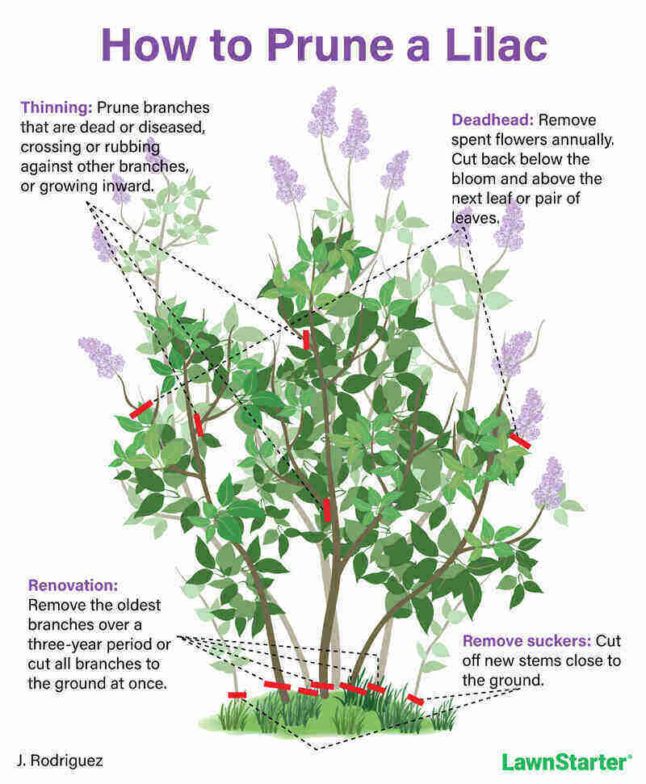
Before you begin, make sure you’re well equipped. You’ll want a few special tools for this job.
- Pruning saw: Usually no more than a 7-inch blade for larger cuts
- Loppers: Long-handled pruners used to cut branches 0.5 to 1.5 inches thick
- Hand pruners: Used for pruning pencil-sized branches or smaller
It’s important to know what you want to accomplish before you start to snip.
Goal #1: Remove spent flowers: This is a process called deadheading. Do this annually to remove spent foliage and encourage new growth.
Goal #2: Remove new shoots: These shoots, or suckers, are the new growth coming up from the ground around the base of the lilac. This should be done annually.
Goal #3: Remove dead, damaged, diseased, or crossing branches: This is known as thinning your lilac bush. Thinning opens up the bush to allow for greater airflow and helps to shape the lilac and control its height. It also helps to keep the branches healthy and should be done annually, as needed.
Goal #4: Renovate your lilac: There may be times when your lilac has gotten too large (12 feet or higher), or there are too many branches crowding the shrub. In these cases, renovating or cutting back the bush completely can help to bring it back to its natural glory.
Now that you know what you want to accomplish, here’s how to do it:
How to Deadhead a Lilac Bush
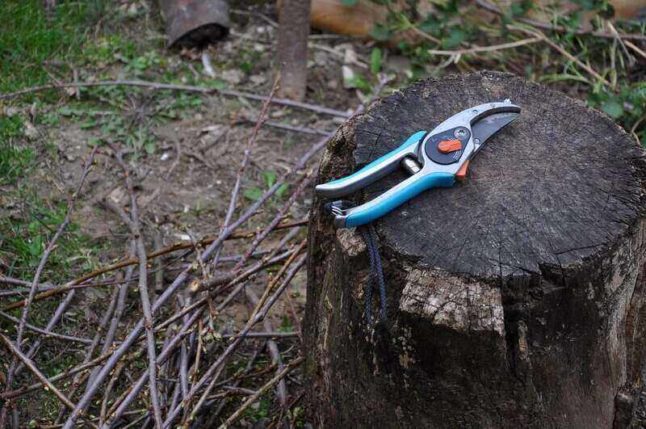
Deadheading is the process of removing dead flower heads on the stem in order to make room for the new growth the next season. Deadheading a lilac should be done as regular yearly maintenance after each spring season. When the flowers are fading and starting to die, it’s time to grab your pruning shears and start trimming.
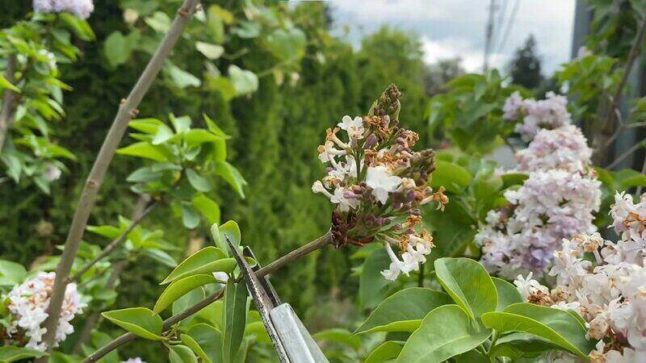
- Locate your spent flower, and find the first pair of leaves or a significant side branch to cut back to.
- Use pruners to cut dead flower heads off at the stem back to the pair of leaves or significant side branch. This promotes next year’s flowers.
How to Remove Suckers

Suckers are the new growth (stems) coming up from the ground. You can tell these are suckers if they aren’t attached to the main branch of the shrub. Suckers will become flowering stems and add to your shrub’s volume in coming years, so remove those you don’t want to keep during your annual pruning.
- Cut off any unwanted shoots that are growing from the ground, as these will draw energy from the rest of the plant.
- Try to cut as close to the ground as possible so no shoots stick out.
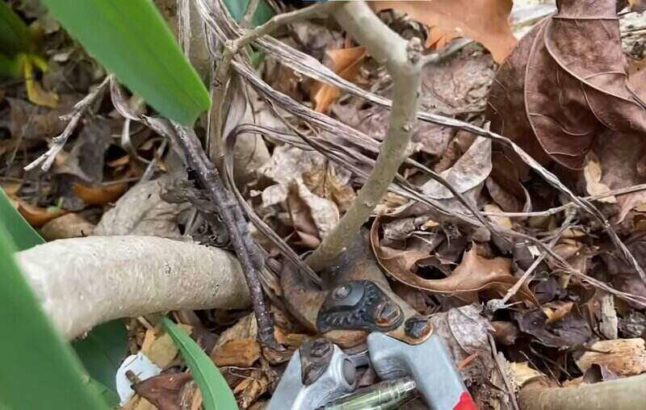
In the case that you would like more than one lilac bush, you might want to keep the suckers. Digging out and replanting these suckers is what’s known as propagating. Propagating is when you grow a new plant by using, in this case, a vegetative part of the original plant. Common techniques involve cuttings, root sprouts, layering, or cleft and bud grafts.
This can be a helpful way to get more lilac bushes or other flowering shrubs without the cost of having to go out and buy a new one.
How to Thin a Lilac

Improve air circulation by trimming stems that are growing inward, towards the inner branches.
- Cut any dead, diseased, or weak branches.
- Cut any crossing branches that rub against other branches.

Photo Credit: Gardening with Creekside / Youtube
This will allow more light to pass through the shrub. You can trim other areas as needed, but try not to remove more than one-third of the plant per year.
Pro Tip: If you are trying to reduce the size of your lilac bush, cutting back to a larger, sturdier side branch can help reduce the height of your shrub.
How to Renovate a Lilac Bush

For those lilac bushes that have grown too tall, over 12 feet, it may be time to renovate your plant. There are two ways that you can do this.
The first way to renovate a lilac bush:
- Remove the oldest branches over two or three consecutive seasons. Never remove more than one-third at a time. Take these branches down all the way to the main stem or cut the entire stem to within a foot off the ground.
- Trimming should be completed in the early spring or late winter before the bush has bloomed.
- Fertilize throughout this process to ensure new strong and healthy growth.
- Cut any overgrown tops back to a main branch to reduce the size of the branches.
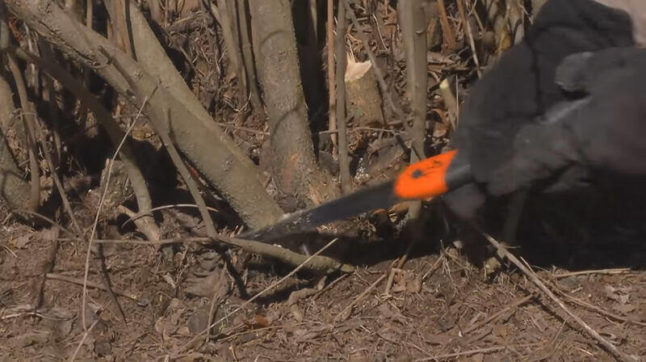
The second way to renovate a lilac bush is by cutting the entire shrub down to less than a foot above the ground. New growth will begin with the spring season and blooms should arrive around the third year although this happens sooner for some lilacs. The lilac should reach its mature height within a few years.
The bushes generally don’t need to be pruned until they reach about six to eight feet. Blooms aren’t able to form unless the stems are at least three years old. Up until this point, you do not need to prune. Once you notice more branches and some buds (after three years), you can begin deadheading annually again.
Pro Tip: Make sure your tools are clean and sharpened to remove any exhausted blooms or spent flowers. This will encourage further blooming in the future and help to get your dying bush back on track.
FAQ About Lilac Bushes
It’s better to prune lilac bushes in the late spring, not the fall. By pruning in the fall, you cut off the majority of new buds, which is a common reason why lilacs don’t bloom in the spring. If you need to renovate your shrub, late winter to early spring is a better time to do this.
Depending on how severe the overgrown bush is, you may want to consider cutting it down to 6-12 inches off the ground. This is called renovating your lilac bush and it involves cutting all of the branches down in order to help encourage new growth that can be more controlled.
Renovation helps when the shrub has not been pruned regularly and has large, overgrown branches reaching a height of 12 feet or more. By cutting the branches down, you can more easily control the shape and size as it grows. However, it can take a few years for it to start blooming again.
You should start seeing strong growth in the second year with most shrubs showing blooms in the third year. At this point, annual deadheading is recommended.
Another less severe approach is the thinning method of taking off the bigger, older branches. Remember, you should only prune one-third of the bush per season, so this process could take two to three consecutive seasons depending on the lilac. You’ll want to trim the bigger branches down to 6-12 inches from the ground before going in and thinning out the middle section.
In the middle section, you should look for any dead or damaged wood that could give way to disease. Getting those branches and any crossing branches off should help to further encourage airflow and a cleaner look for your lilac shrub.
You can cut as far back as within a foot of the ground through the renovating process. Most seasonal pruning should be much less. Usually, if you’re going to cut a branch or limb, you should try to cut back to another branch or to 6-12 inches from the ground. This method helps to protect against disease in the shrub and also adds to the aesthetic look of the bush.
Keeping up With Your Lilac
Don’t be afraid to make the first cut. Understanding the needs of your lilac bush and knowing when to prune it is all a part of being a plant owner. Being a plant owner also means knowing when to call in the professionals. For further help with pruning lilacs, other flowering shrubs, or landscaping, consider calling a local landscaping pro.
Main Image Credit: Pxhere / CC0 1.0